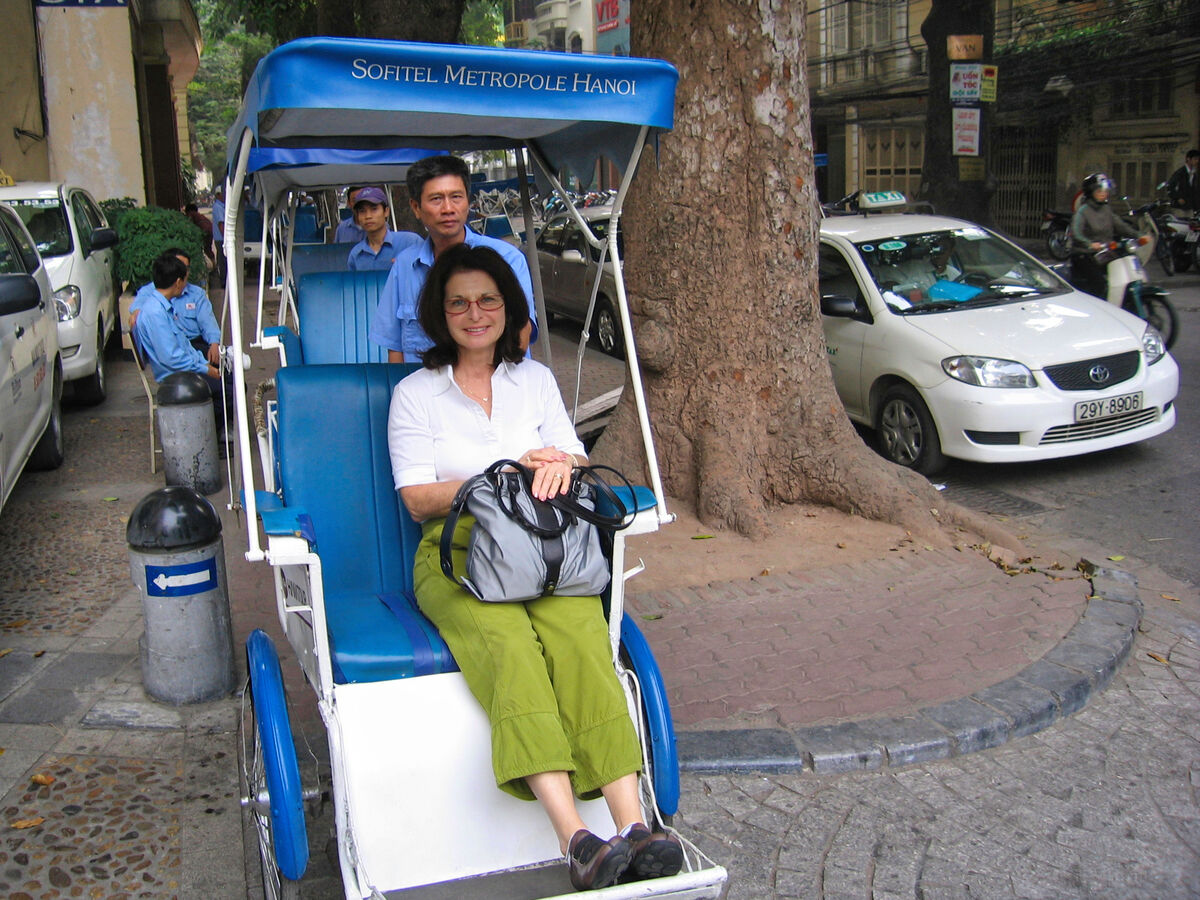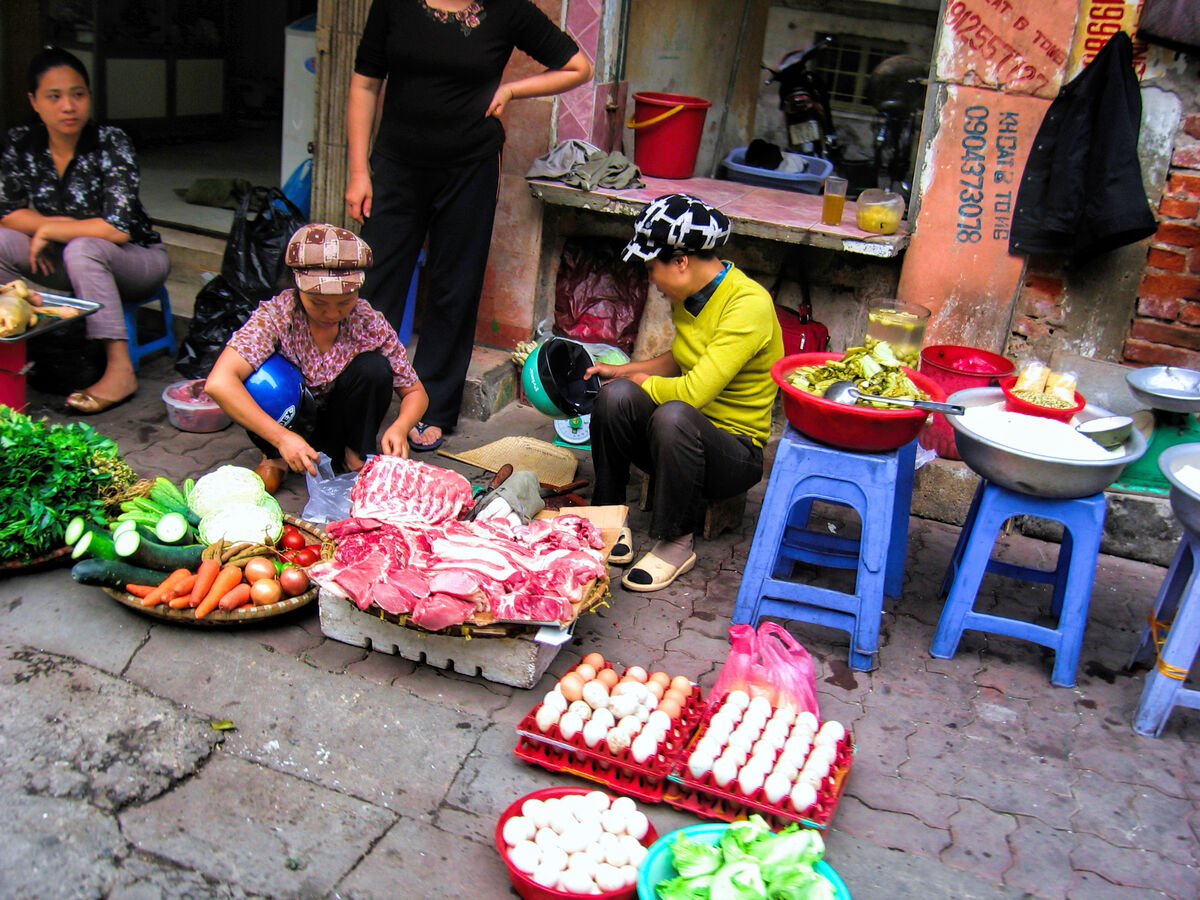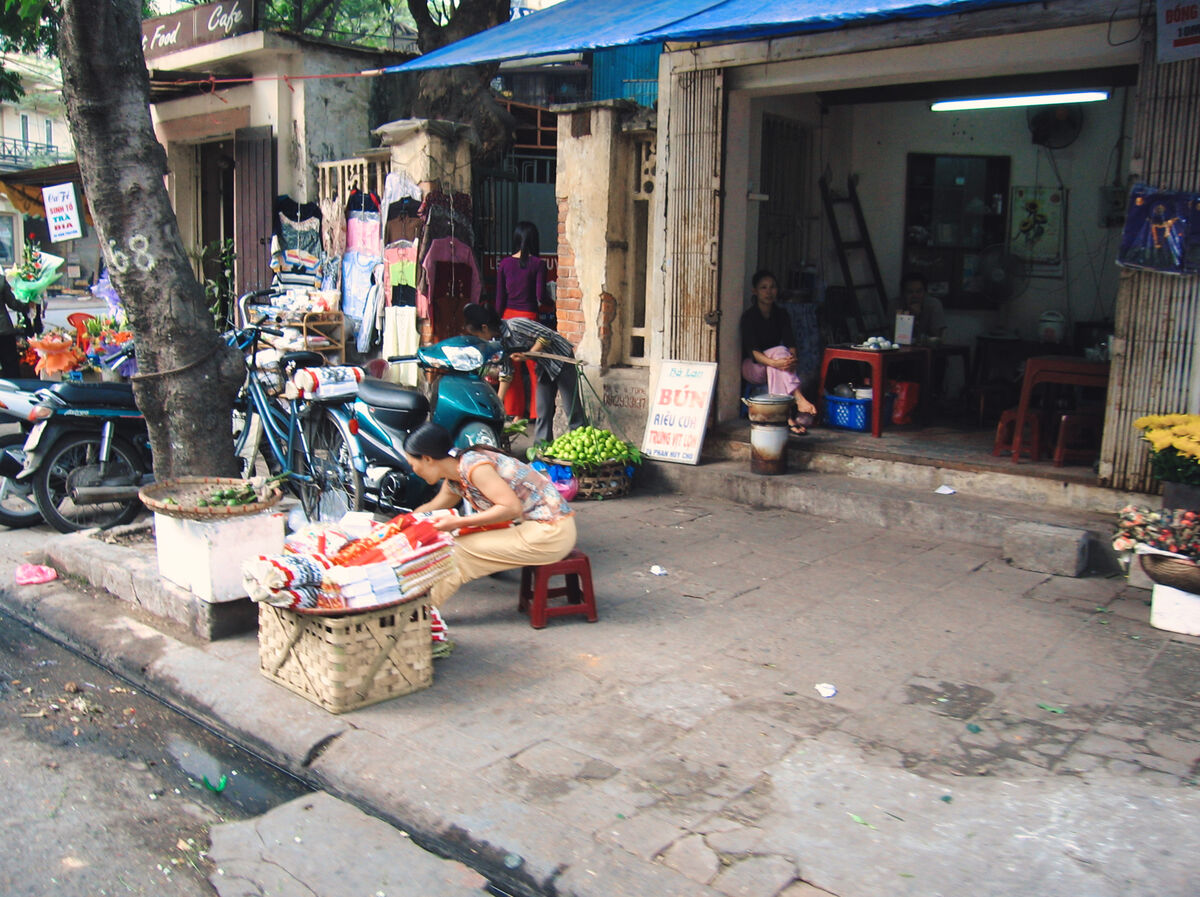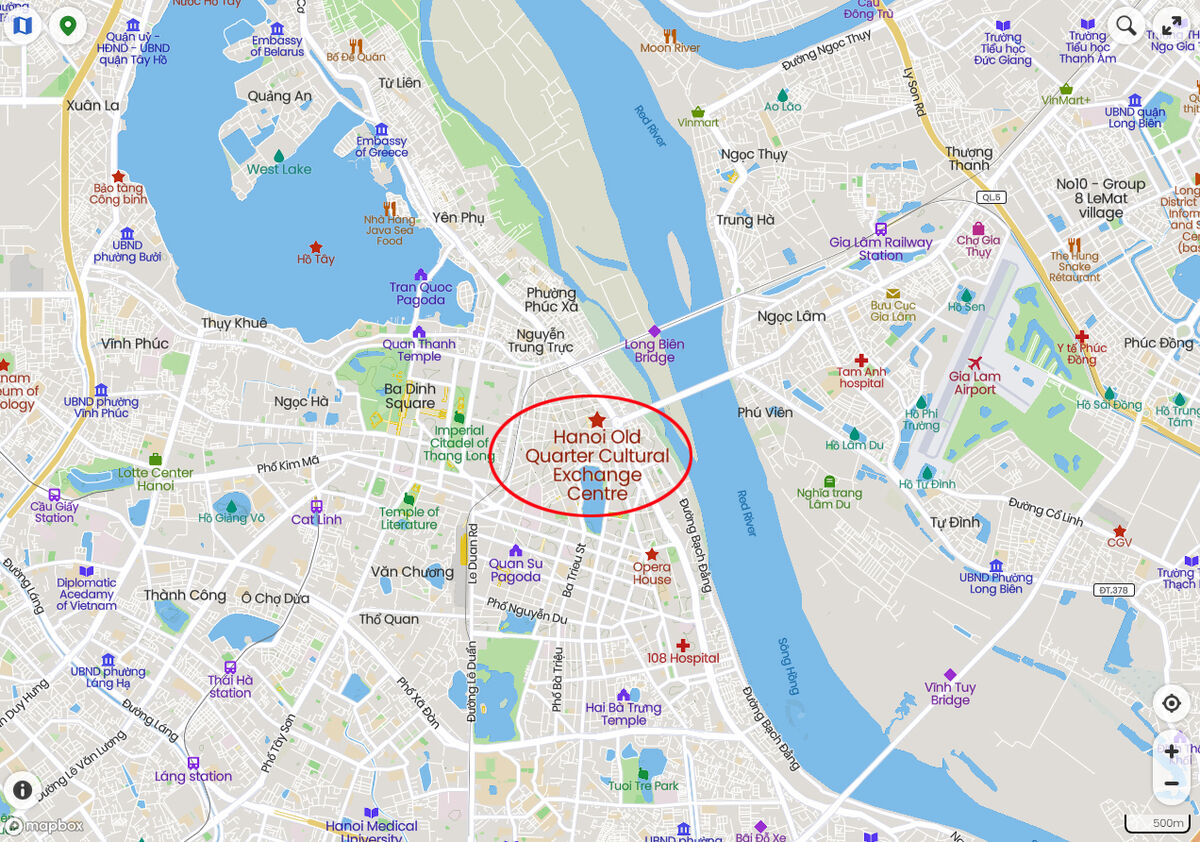Vietnam: Hanoi Part 5 - Touring The Old City By Cyclo
Aug 29, 2022 14:52:05 #
The highlight of our second day in Hanoi was sightseeing in the Old Quarter by cyclo. Not only was it a fun leisurely ride, it gave me a great perspective to photograph the scenery at street level without worrying about reflections from the tour bus windows and allowed me to capture people without getting in their faces. All were taken with a Canon Powershot SX-60.
The cycle rickshaw is a small-scale local means of transport. It is a type of hatchback tricycle designed to carry passengers on a for-hire basis. It is also known by a variety of other names such as bike taxi, velotaxi, pedicab, bikecab, cyclo, beca, becak, trisikad, sikad, tricycle taxi, trishaw, or hatchback bike.
As opposed to rickshaws pulled by a person on foot, cycle rickshaws are human-powered by pedaling. Another type of rickshaw is the auto rickshaw.
The first cycle rickshaws were built in the 1880s, and they were first used widely in 1929 in Singapore. Six years later they outnumbered pulled rickshaws. By 1950 cycle rickshaws were found in every south and east Asian country. By the late 1980s there were an estimated 4 million cycle rickshaws in the world.
The vehicle is generally pedal-driven by a driver, though some are equipped with an electric motor to assist the driver. The vehicle is usually a tricycle, though some quadracycle models exist, and some bicycles with trailers are configured as cycle rickshaws. Some cycle rickshaws have gas or electric motors.
The configuration of driver and passenger seats varies. Generally the driver sits in front of the passengers to pedal the rickshaw. There are some designs, though, where the cyclist driver sits behind the passengers. In many Asian countries, like Bangladesh, India and China, the passenger seat is located behind the driver, while in Indonesia, Malaysia, Cambodia and Vietnam the driver sits behind the passenger seat. In the Philippines, the passenger seats are usually located beside the driver in a side car. Similarly, in the trishaw in Singapore and the sai kaa in Burma the passengers sit alongside the driver.
https://en.wikipedia.org/wiki/Cycle_rickshaw
THE OLD QUARTER (Vietnamese: Phố cổ Hà Nội) is the name commonly given to the historical civic urban core of Hanoi, located outside the Imperial Citadel of Thăng Long. This quarter used to be the residential, manufacturing and commercial center, where each street was specialized in one specific type of manufacturing or commerce.
Another common name referring to approximately the same area is the 36 streets (Vietnamese: Hà Nội 36 phố phường), after the 36 streets or guilds that used to make up the urban area of the city.
The residential and commercial area that is now the Old Quarter came to be during the Lý and Trần dynasties and was then located east of the Imperial Citadel of Thăng Long and along the Red River. During the Lê dynasty, scholar Nguyễn Trãi already mentioned some of the areas each specialized in one particular trade. It was then surrounded by a defensive wall with several gates.
During the Lê dynasty, the area included several lakes and wetlands, the largest of which was Thái Cực lake. These lakes, as well as the Tô Lịch River were connected with Hoàn Kiếm lake and the Red River. Near the end of the 19th century these lakes and rivers became isolated from each other.
During the Lý and Trần dynasties, many people from the surrounding plains migrated to the city and settled in what is now the Old Quarter, creating the densest urban area of the city. The Lê dynasty period saw an additional influx of Chinese immigrants who arrived to trade, creating several Chinese neighbourhoods..
When the French ruled over Vietnam, they partially rebuilt the area. This period saw many French and Indians settling there to conduct business. Two small markets were demolished to make place for Đồng Xuân Market. Furthermore a tramway was constructed through the quarter. The area is still the commercial heart of Hanoi.
The most famous trait of the Old Quarter are its areas dedicated to one specific trade or guild. Craftsmen from villages around the city used to gather in one area of their guild to sell their wares to merchants. The crafts or guilds of each area gave the names to the streets of the quarter, so that most streets acquired names starting with hàng ("wares"), such as Hàng Tre street ("bamboo wares street") and Hàng Đồng street ("copper wares street").
Several of the streets are still specialized in the trade that gave them their names. Others still specialize in one specific trade, but a different one from their traditional specialty — such as Hàng Buồm street ("sails street") which has become dominated by Vietnamese cakes and candy.
The Old Quarter has been shown by researchers using the quantitative social anthropology approach to have exhibited Hanoi's cultural evolution during the first decades of the 20th century.
The Old Quarter contains many historic sights, such as temples, pagodas, and assembly halls.
Most craft streets used to have a temple dedicated to worshiping mythical founders of the craft. Particular is that the ground floor of such communal temples in the Hanoi Old Quarter was often still used for commerce. With the passage of time, most such communal temples have been destroyed. Several temples have survived, such as the Mã Mây and Kim Cổ temples.
Several city gates were located in what is now the Old Quarter. Only the Quan Chưởng gate is still left
Characteristic of the Old Quarter is the ancient architecture of the commercial area. Most of the historic houses there are shophouses with slanted tile roofs, of which the side facing the street used to be used as entrance to the shop inside. Houses of this type were mostly built in the 18th and 19th centuries — before that most houses had thatched roofs.
Since the end of the 20th century, the number of traditional houses have been dwindling in number.
https://en.wikipedia.org/wiki/Old_Quarter,_Hanoi
For additional images of Hanoi, Please see my previous posts:
https://www.uglyhedgehog.com/t-749364-1.html
https://www.uglyhedgehog.com/t-749643-1.html
https://www.uglyhedgehog.com/t-749886-1.html
https://www.uglyhedgehog.com/t-750093-1.html
I hope you enjoy these!
Mark
The cycle rickshaw is a small-scale local means of transport. It is a type of hatchback tricycle designed to carry passengers on a for-hire basis. It is also known by a variety of other names such as bike taxi, velotaxi, pedicab, bikecab, cyclo, beca, becak, trisikad, sikad, tricycle taxi, trishaw, or hatchback bike.
As opposed to rickshaws pulled by a person on foot, cycle rickshaws are human-powered by pedaling. Another type of rickshaw is the auto rickshaw.
The first cycle rickshaws were built in the 1880s, and they were first used widely in 1929 in Singapore. Six years later they outnumbered pulled rickshaws. By 1950 cycle rickshaws were found in every south and east Asian country. By the late 1980s there were an estimated 4 million cycle rickshaws in the world.
The vehicle is generally pedal-driven by a driver, though some are equipped with an electric motor to assist the driver. The vehicle is usually a tricycle, though some quadracycle models exist, and some bicycles with trailers are configured as cycle rickshaws. Some cycle rickshaws have gas or electric motors.
The configuration of driver and passenger seats varies. Generally the driver sits in front of the passengers to pedal the rickshaw. There are some designs, though, where the cyclist driver sits behind the passengers. In many Asian countries, like Bangladesh, India and China, the passenger seat is located behind the driver, while in Indonesia, Malaysia, Cambodia and Vietnam the driver sits behind the passenger seat. In the Philippines, the passenger seats are usually located beside the driver in a side car. Similarly, in the trishaw in Singapore and the sai kaa in Burma the passengers sit alongside the driver.
https://en.wikipedia.org/wiki/Cycle_rickshaw
THE OLD QUARTER (Vietnamese: Phố cổ Hà Nội) is the name commonly given to the historical civic urban core of Hanoi, located outside the Imperial Citadel of Thăng Long. This quarter used to be the residential, manufacturing and commercial center, where each street was specialized in one specific type of manufacturing or commerce.
Another common name referring to approximately the same area is the 36 streets (Vietnamese: Hà Nội 36 phố phường), after the 36 streets or guilds that used to make up the urban area of the city.
The residential and commercial area that is now the Old Quarter came to be during the Lý and Trần dynasties and was then located east of the Imperial Citadel of Thăng Long and along the Red River. During the Lê dynasty, scholar Nguyễn Trãi already mentioned some of the areas each specialized in one particular trade. It was then surrounded by a defensive wall with several gates.
During the Lê dynasty, the area included several lakes and wetlands, the largest of which was Thái Cực lake. These lakes, as well as the Tô Lịch River were connected with Hoàn Kiếm lake and the Red River. Near the end of the 19th century these lakes and rivers became isolated from each other.
During the Lý and Trần dynasties, many people from the surrounding plains migrated to the city and settled in what is now the Old Quarter, creating the densest urban area of the city. The Lê dynasty period saw an additional influx of Chinese immigrants who arrived to trade, creating several Chinese neighbourhoods..
When the French ruled over Vietnam, they partially rebuilt the area. This period saw many French and Indians settling there to conduct business. Two small markets were demolished to make place for Đồng Xuân Market. Furthermore a tramway was constructed through the quarter. The area is still the commercial heart of Hanoi.
The most famous trait of the Old Quarter are its areas dedicated to one specific trade or guild. Craftsmen from villages around the city used to gather in one area of their guild to sell their wares to merchants. The crafts or guilds of each area gave the names to the streets of the quarter, so that most streets acquired names starting with hàng ("wares"), such as Hàng Tre street ("bamboo wares street") and Hàng Đồng street ("copper wares street").
Several of the streets are still specialized in the trade that gave them their names. Others still specialize in one specific trade, but a different one from their traditional specialty — such as Hàng Buồm street ("sails street") which has become dominated by Vietnamese cakes and candy.
The Old Quarter has been shown by researchers using the quantitative social anthropology approach to have exhibited Hanoi's cultural evolution during the first decades of the 20th century.
The Old Quarter contains many historic sights, such as temples, pagodas, and assembly halls.
Most craft streets used to have a temple dedicated to worshiping mythical founders of the craft. Particular is that the ground floor of such communal temples in the Hanoi Old Quarter was often still used for commerce. With the passage of time, most such communal temples have been destroyed. Several temples have survived, such as the Mã Mây and Kim Cổ temples.
Several city gates were located in what is now the Old Quarter. Only the Quan Chưởng gate is still left
Characteristic of the Old Quarter is the ancient architecture of the commercial area. Most of the historic houses there are shophouses with slanted tile roofs, of which the side facing the street used to be used as entrance to the shop inside. Houses of this type were mostly built in the 18th and 19th centuries — before that most houses had thatched roofs.
Since the end of the 20th century, the number of traditional houses have been dwindling in number.
https://en.wikipedia.org/wiki/Old_Quarter,_Hanoi
For additional images of Hanoi, Please see my previous posts:
https://www.uglyhedgehog.com/t-749364-1.html
https://www.uglyhedgehog.com/t-749643-1.html
https://www.uglyhedgehog.com/t-749886-1.html
https://www.uglyhedgehog.com/t-750093-1.html
I hope you enjoy these!
Mark
Gail's driver was very happy with her 110 lb. frame, my driver, not so happy!

(Download)

(Download)

(Download)

(Download)

(Download)

(Download)

(Download)

(Download)

(Download)

(Download)
Aug 29, 2022 14:54:47 #
Aug 29, 2022 14:58:54 #
Aug 29, 2022 15:02:07 #
angler wrote:
Excellent interesting as always Mark.
Thanks so much Jim. I always appreciate your kind comments.
Aug 29, 2022 15:09:40 #
Aug 29, 2022 15:38:41 #
Aug 29, 2022 15:56:34 #
azted
Loc: Las Vegas, NV.
If I'm not being to forward....your wife has a very pretty and kind face! Nonetheless, your images from Hanoi are real ground level artwork, showing the lifestyle of the gritty locals. Contrasting to this due to climate is the Saigon area, where greater wealth still exists, or at least did when I was there.
Aug 29, 2022 19:39:52 #
ecobin wrote:
Thanks for the history lesson and excellent photos!
You're most welcome Elliott. My pleasure!
Aug 29, 2022 19:40:16 #
Aug 29, 2022 19:42:11 #
azted wrote:
If I'm not being to forward....your wife has a very pretty and kind face! Nonetheless, your images from Hanoi are real ground level artwork, showing the lifestyle of the gritty locals. Contrasting to this due to climate is the Saigon area, where greater wealth still exists, or at least did when I was there.
Thanks so much Ted. Saigon images to come later. Gail much appreciates your kind comments as do I.
Aug 29, 2022 21:17:59 #
Aug 30, 2022 00:56:40 #
srfmhg wrote:
The highlight of our second day in Hanoi was sigh... (show quote)
Great city scenes Mark, they really give you a sense of the place. It looks like language would be a real issue. We enjoyed a pedicab tour of Central Park in New York in 2019, but with the driver in front. Then he took us up 7th Avenue to Times Square in the pedicab in the late afternoon traffic; that was an exciting ride.
Aug 30, 2022 02:26:11 #
kpmac wrote:
Excellent street photography in a foreign country. Great set, Mark.
Thanks very much Ken. Glad you liked them.
Aug 30, 2022 02:28:15 #
DJphoto wrote:
Great city scenes Mark, they really give you a sense of the place. It looks like language would be a real issue. We enjoyed a pedicab tour of Central Park in New York in 2019, but with the driver in front. Then he took us up 7th Avenue to Times Square in the pedicab in the late afternoon traffic; that was an exciting ride.
Thanks very much Dennis. It’s a great way to see the city. We had a cyclo tour in Hue as well which I’ll post soon.
Aug 30, 2022 07:19:27 #
If you want to reply, then register here. Registration is free and your account is created instantly, so you can post right away.








